Litton C.W., . Reynolds D.C., Collins T.C. Zinc Oxide Materials for Electronic and Optoelectronic Device Applications
Подождите немного. Документ загружается.


Furthermore, observation of the atomic force microscopy (AFM) images revealed that the
surface of an MQW is composed of well-defined atomically flat terraces and steps
corresponding to the charge neutral unit of ZnO. In other words, the interface roughness
in the heterostructure cannot be larger than 0.26 nm. It can be said that ZnO and MgZnO alloy
layers grow in a two-dimensional growth mode on this substrate, resulting in the formation of
a sharp hetero-interface between them.
We show, in Figure 12.1, luminescence (PL) and absorption spectra in ZnO/
Mg
0.12
Zn
0.88
O MQWs on SCAM substrates measured at 5 K with well widths ( L
w
)of
17.5 and 6.9 A
. Also shown for comparison in the bottom panel of the figure is PL and
absorption spectra in a 500-A
-thick ZnO epilayer on the lattice-matched SCAM substrate.
Both the PL and absorption peaks shifted towards the higher energy side as L
w
decreased.
This shift resulted from a quantum confinement effect. For ref erence, we note that the
exciton Bohr radius is 18 A
.
[29]
The absorption peaks (n ¼ 1) arise from the lowest
excitonic states of well layers. The peak energies of PL were constantly located on the
lower energy side of those of absorption peaks.
The well width dependences of the peak energies of PL (closed circles) and absorption
(open squares) are shown in Figure 12.2(b) and (c), respectively.
[28]
The lowest transition
energy of excitons (open triangles) formed with confined electrons and holes was
calculated using a model of one-dimensional, finite periodic square-well potential
proposed by Gol’dman and Krivchnokov.
[30]
The exciton binding energy (60 meV)
[31]
Absor
p
tion
4.03.83.63.43.2
Photon Ener
gy
(eV)
Normalized PL Intensity (arb. units)
ZnO(500A)
barrier abs.
17.5A
(3.5L)
He-Cd
5.0 K
L
w
= 6.91A
(1.5L)
n =1
n 2
n 2
n = 1
A, B
B+LO
B+2LO
B+3LO
I
6
Figure 12.1 PL and absorption spectra obtained from ZnO/Mg
0.12
Zn
0.88
O MQWs measured
at 5 K for L
w
of 17.5 and 6.9 A
. The absorption energy of the barrier layers is shown by a
horizontal arrow. Spectra obtained from a 500-A
-thick ZnO film are also shown. “B þLO,
B þ2LO, and B þ3LO” correspond to exciton–phonon complex transitions, “n ¼ 1” shows the
lowest excitonic absorption of the well layers, and “n 2” means the excited states of the
exciton or higher interband transitions. Reprinted from Makino, T., et al., Room-temperature
luminescence of excitons in ZnO/(Mg,Zn)Omulti-quantum wells on lattice-matched substrates,
App. Phys. Lett., 77,975. Copyright (2000) with permission from American Institute of Physics
334 Room-Temperature Stimulated Emission from ZnO Multiple Quantum Wells
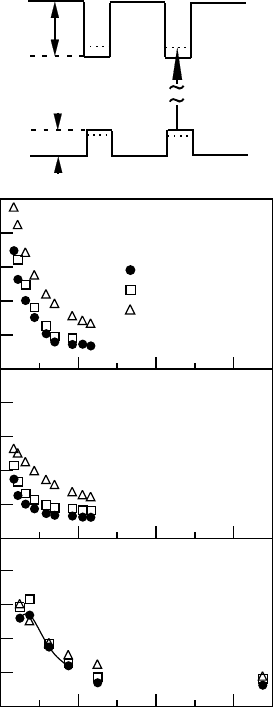
3.7
3.6
3.5
3.4
3.3
12080400
Well width (A)
(d)
ZnO(L
w
)/Mg
0.15
Zn
0.85
O
on sapphire
3.7
3.6
3.5
3.4
3.3
(c)
ZnO(L
w
)/Mg
0.12
Zn
0.88
O
on SCAM
Exciton Resonant Energy (eV)
3.8
3.7
3.6
3.5
3.4
3.3
(b)
ZnO(L
w
)/Mg
0.27
Zn
0.73
O
on SCAM
PL
Abs
Calc
(a) ZnO/Mg
0.12
Zn
0.88
O MQW
L
w
E
c
189 meV
21 meV
E
v
Figure 12.2 (a) Diagram of conduction and valence bands between barrier and well layers in
a ZnO/Mg
0.12
Zn
0.88
O MQW.
[9]
The upward arrow shows the lowest interband transition. (b)
Peak energies of PL (circles) and absorption (squares) are plotted against L
w
in [ZnO/
Mg
0.27
Zn
0.73
O]
10
on SCAM substrates. Results of calculation (triangles) of the interband
transition energy that include the excitonic effect are also shown. (c) Similar except that the
Mg content was 12%. (d) Similar except that the substrate was sapphire. The Mg content was
15%. Energies of PL excitation spectra (squares) are plotted instead of those of absorption
spectra, due to the presence of 100-nm-thick ZnO buffer layers. Note that the peak energies of
PL excitation spectra coincide with those of the absorption spectra. The curve is a visual
guide.
[28]
Reprinted from Makino, T., et al., Room-temperature luminescence of excitons in
ZnO/(Mg,Zn)Omulti-quantum wells on lattice-matched substrates, App. Phys. Lett., 77,975.
Copyright (2000) with permission from American Institute of Physics
Quantum Confinement Effect of Excitons in QWs 335
is assumed to be independent of L
w
here. The optical transition process on a ZnO/
Mg
0.12
Zn
0.88
O MQW is shown in Figure 12.2(a). This tendency of the L
w
dependence of
the exciton transition energy was consistent with the calculation results. As reported by
Coli and Bajaj,
[32]
incorporation of the effects of exciton–phonon interaction and the
quantum confinement in calculation, leads to values of the excitonic transitions that are in
good agreement with our experimental data. Figure 12.2(d) shows the corresponding peak
energy plot for MQWs grown on sapphire substrates. As shown in Figure 12.2(d), both
peak energies have a maximum at L
w
of 15 A
when sapphire substrates were employed.
This indicates a critical thickness that prevents quantum confinement with respect to the
exciton energy. It is speculated that the existence of the critical thickness corresponds to
the poor controllability of layer thickness due to the lattice mismatching.
12.4 Exciton–Phonon Interaction in QWs
Despite the viable technological applications and remarkable achievements of ZnO, the
fundamental properties, such as electron–phonon interaction are less understood. The
intrinsic properties cannot be controlled but must be understood since they play an
essential role in the device operations. The coupling constant between excitons and
phonons in ZnO QWs (MQWs) has not been evaluated quantitatively so far. We quantify
the coupling constant by estimating the temperature dependence of the absorption spectra.
Figure 12.3 shows the temperature depend ence of the full width at half-maximum
(FWHM) of the excitonic absorption peaks for a ZnO epilayer [Figure 12.3(a)] and for
a typical MQW sample with a QW width of 17.5 A
[Figure 12.3(b)]. The solid line
represents the fitted results based on Equation (12.1). The temperature dependence of the
FWHM can be approximately described by:
[33]
GðTÞ¼G
0
þg
ph
T þG
LO
=½expðhv
LO
=k
B
TÞ1ð12:1Þ
where G
0
, hv
LO
(72 meV), g
ph
, G
LO
and k
B
are the inhomogeneous linewidth at
temperature (T) of 0 K, longitudinal optical (LO)-phonon energy, strengths of the
exciton-acoustic-phonon and the exciton-LO-phonon couplings and the Bolzmann con-
stant, respectively. It was experimentally found that hv
LO
of the MQWs is not different
from the bulk value.
Figure 12.4 (closed circles, left axis) shows the values of G
LO
obtained for the epilayer
and its well width (L
w
) dependence obtained for ZnO/Mg
0.12
Zn
0.88
O MQWs. The values
of G
LO
of the MQWs are smaller than those for the epilayers and monotonically decrease
with decrease in L
w
. Here we try to explain this result by the enhancement of exciton
binding energy induced by the quantum confinement effect. Figure 12.4 (open circles,
right axis) shows the L
w
dependence of exciton binding energy. This depend ence was
determined by studying spectra of stimulated emiss ion. As is well known, the major
process that contributes to broadening of the exciton linewidth is scattering of 1S excitons
into the free-electron–hole continuum or into excited excitonic states by absorbing LO
phonons. If exciton binding energy exceeds hv
LO
(72 meV), dissociation efficiency into
the continuum states is greatly suppressed compared with the case of exciton binding
energy smaller than hv
LO
. In such case, G
LO
is reduced. Indeed, exciton binding energy
336 Room-Temperature Stimulated Emission from ZnO Multiple Quantum Wells
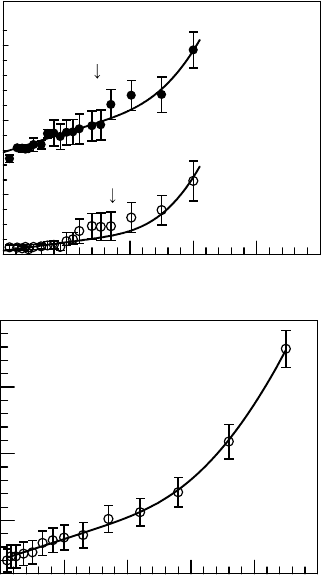
exceeds hv
LO
in the case of MQWs. A similar effect has also been observed in other QW
systems.
[37]
A schematic explanation is described in the literature.
[35,38]
12.5 The Localization Mechanism of the Exciton in a QW
It was found that the excitonic luminescence in the ZnO MQWs under investigation is
due to radiative recombination from excitons localized by the potentials form ed by the
fluctuation s of L
w
and barrier height. Our spectral as signments are based on (1) the well
width dependence of Stokes shift (difference between the energies of absorption and
luminescence bands), (2) the temperature dependence of PL spectra, and (3) the
spectral distribution (luminescence energy dependence) of decay time constants of
35
30
25
20
FWHM (meV)
250200150100500
Tem
p
erature (K)
(b) ZnO quantum well
(well width = 50 Å)
15
10
5
FWHM (meV)
250200150100500
Temperature (K)
A-exciton
B-exciton
(a) ZnO epilayer
Figure 12.3 (a) Width (full width at half-maximum, FWHM, circles) of A- and B-exciton
absorption bands plotted as a function of temperature. Open circles are data of the A-excitons
and the closed circles are data of the B-excitons. The solid curves represent the fitting results.
(b) Similar plot for the MQW with Mg concentration of 0.12 and L
w
of 46.5 A
.
[34,35]
Reprinted
from Sun, H. D., et al., Temperature dependence of the exciton linewidth in ZnO/(Mg,Zn)O
multi-quantum wells grown on lattice matched substrates. Appl. Phys. Lett. 78, 2464. Copyright
(2001) with permission from American Institute of Physics
The Localization Mechanism of the Exciton in a QW 337
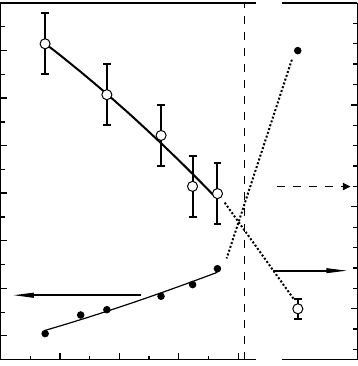
luminescence.
[28,35,39,40]
A typical example of the spectr al distri bution of decay time
constants is shown in Figure 12.5(b). Her e, the temperature dependence of the PL
spectrum in a QW in the case of magnesium composition of 0.27 is described in detail.
Figure 12.5(a) shows the temperature dependence of PL (solid line) and that of
absorption (broken line) spectra in ZnO(17.5 A
)/Mg
0.27
Zn
0.73
O MQWs over a temperature
range of 5–300 K. It should be noted that spectra obtained at temperatures between 95 K
and 200 K had two peaks, both of which originated from a recombination of localized
excitons. The separation of these peaks was 12–20 meV. Figure 12.5(b) shows PL decay
time as a function of monitored photon energy at 5 K in the same MQW. The solid curve is
the results of theoretic al calculation based on the model of the excitonic localization.
[28,41]
Figure 12.6(a) summarizes peak energies of the PL spectra (E
pk
PL
) (open circles and
triangles) and the excitonic absorption energy (open squares) as functions of temperatures.
It should be noted that the higher PL peak position does not coincide with that of
absorption spectra even at temperatures near room temperature. We also examined, for
comparison, the temperature dependence of PL peak energy in an MQW having a lower
barrier height: a ZnO/Mg
0.12
Zn
0.88
O MQW with a well width of 27.9 A
. Figure 12.6(b)
shows the peak energies of PL (circles ) and absorption (squares) spectra in this sample. In
this case, the energies of luminescence and absorption are the almost the same as each
other at temperatures near room temperature. Two kinds of MQWs having different barrier
heights showed significantly different temperature dependences of PL spectra.
Following a temperature rise, the PL energy of ZnO(17.5 A
)/Mg
0.27
Zn
0.73
O MQWs
exhibited low energy shifts between 5 K and 50 K, blue-shifts between 50 K and 200 K,
and again shifts to a low energy side at temperatures higher than 200 K. Furthermore, at
temperatures between 95 K and 200 K, the spectra had two peaks, both of which originated
90
80
70
60
Exciton bindin
g
ener
g
y (meV)
54321
Well width (nm)
900
800
700
600
500
400
300
200
Exciton-LO-phonon coupling Γ
LO
(meV)
~
~
~
~
ZnO/Zn
0.88
Mg
0.12
O MQW
Bulk ZnO
hω
LO
Figure 12.4 Strengths of coupling between excitons and LO phonons G
LO
(closed circles) and
exciton binding energies (open circles) in bulk ZnO and MQWs with different L
w
s.
[36]
The solid
curve is a visual guide
338 Room-Temperature Stimulated Emission from ZnO Multiple Quantum Wells
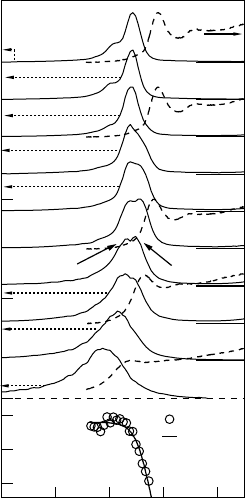
from a recombination of localized excitons. The absorption peak energies both in ZnO
epilayers and in MQWs are monotonically decreasing functions of temperature as was
revealed in previous studies.
[34,35]
This can be explained in terms of narrowing of the
fundamental energy gap induced by a temperature rise.
In general, when a dominant PL peak is assigned to a radiative recombination of localized
excitons, its peak energy blue-shifts with increase in temperature in a range of low
temperatures and red-shifts at higher temperatures. The E
pk
PL
blue-shifts and continuously
connects to that of free excitons due to thermal activation of localized excitons. The E
pk
PL
of the
free-excitonic emission is a monotonically decreasing function of temperature due to the
band gap shrinkage. The temperature dependence shown in Figure 12.5(a) is, however,
different from the abovementioned typical behavior. The temperature dependence of the
recombination mechanism for localized excitons is thought to be closely related to the
temperature variation in the decay time constant of their PL. Thus temperature dependence of
PL decay times (t
PL
) in an MQW with a L
w
of 27.9 A
is shown in Figure 12.7(c). The t
PL
PL intensity (arb. units)
3.63.53.43.33.2
Photon ener
gy
(eV)
200
150
100
Decay (ps)
(a) L
w
=17.5 Å
x
= 0.27
5 K
25 K
50 K
80 K
95 K
120 K
175 K
200 K
240 K
300 K
Absor
p
tion (arb. units)
LX
1
LX
2
(b) 5 K
exp.
calc.
Figure 12.5 (a) PL (solid line) and absorption (broken line) spectra in a ZnO (17.5 A
)/
Mg
0.27
Zn
0.73
O MQW over the temperature range of 5–300 K. All of the spectra have been
normalized and shifted in the vertical direction for clarity. (b) PL decay times as a function of
monitored photon energy at 5 K in the same MQW. The solid curve is results of the theoretical
calculation based on the model of the excitonic localization. Reprinted from Makino, T., et al.,
Temperature dependence of near ultraviolet photoluminescence in ZnO/(Mg,Zn)O multi-
quantum wells, Appl. Phys. Lett. 78, 1979. Copyright (2001) with permission from American
Institute of Physics
The Localization Mechanism of the Exciton in a QW 339
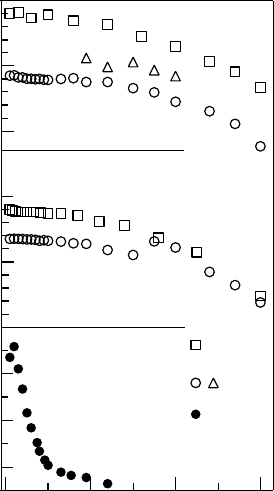
values exhibit nonmonotonical behavior with respect to temperature; the value increased in a
low temperature range and decreased above a certain critical temperature.
The temper ature dependence of the recombination mechanism for localized excitons
can be explained
[42]
as follows: (i) For 5 K G T G 50 K, the relatively long relaxation time
of excitons gives the excitons more opportunity to relax down into lower energy tail states
caused by the inhomogeneous potential fluctuations before recombining. This is because
radiative recombination processes dominate in this temperature range. This behavior
produces a red-shift in the peak energy position with increasing temperature. (ii) For
50 K G T G 95 K, the exciton lifetimes decrease with increasing temperature. Thus, these
excitons recombine before reaching the lower energy tail states. This behavior enhances a
broadening of the higher-energy side emission and leads to a blue-shift in the peak energy.
(iii) For 95 K G T G 200 K, further enhancement of high-energy emission components
produces a new peak, as seen in Figur e 12.6(a ) (triangles). (iv) At temperatures above
200 K, since the excitons are less affected by the temperature-induced rapid change in their
lifetimes and since the relaxation rate of the excitons increased due to an increase in the
3.50
3.45
3.40
Peak energies (eV)
3002001000
Tem
p
erature (K)
3.40
3.35
3.30
Peak energies (eV)
300
200
100
Decay time (ps)
E
abs
pk
E
PL
pk
τ
PL
(b) L
w
=27.9 Å
x
= 0.12
(a) L
w
= 17.5 Å
x
= 0.27
(c) L
w
= 27.9 Å
x =
0.27
Figure 12.6 PL (open circles and triangles) and absorption (open squares) peak positions as a
function of temperature in ZnO(17.5 A
)/Mg
0.27
Zn
0.73
O (a) and ZnO(27.9A
)/Mg
0.12
Zn
0.88
O(b)
MQWs. (c) Temperature dependence of PL decay times, t
PL
, in ZnO(27.9 A
)/Mg
0.27
Zn
0.73
O
MQWs at temperatures of 5–120 K.
[28]
Reprinted from Makino, T., et al., Temperature depen-
dence of near ultraviolet photoluminescence in ZnO/(Mg,Zn)O multi-quantum wells, Appl.
Phys. Lett. 78, 1979. Copyright (2001) with permission from American Institute of Physics
340 Room-Temperature Stimulated Emission from ZnO Multiple Quantum Wells
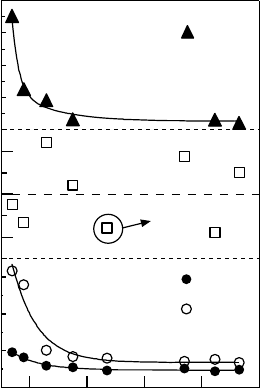
phonon population, blue-shift behavior becomes less pronou nced. Since the energy of
blue-shift is les s than the temperature -induced band gap shrinkage, the peak position
again exhibits a red-shift behavior. As mentioned above, the features of excitonic
spontaneous emission in the well layers are sensitively affected by the dynamics of
recombination of localized exciton states, which significantly vary with temperature.
Readers should refer to the literature for details.
[39]
12.6 Time-Resolved Luminescence in ZnO QWs
Time-resolved PL (TRPL) is a nondestructive and powerful technique that has been
commonly used for the optical characterization of direct-ga p semiconductors. One can
measure by this time-domain spectroscopy the exciton recombination time, an important
parameter related to material quality and device performance. The exciton lifetimes will
vary with crystal quality, becoming longer as the quality improves or localization of the
excitons become deeper.
Reynolds et al.
[43]
measured the recombination lifetime of the free excitons at 2 K in a
single-crystal ZnO grown by the hydrothermal method.
In addition to the time-integrated luminescence, time-resolved luminescence of ZnO
MQW were measured in order to investigate the exciton dynamics in this hetero-structure.
Chia et al.
[44]
presented results of TRPL measurements for the ZnO QWs. Figure 12.7 shows
600
400
200
0
Decay Time Constant (ps)
5040302010
Well Width (Å)
400
300
200
7.0
6.0
5.0
4.0
3.0
Depth (meV)
E
0
τ
PL
τ
rad
τ
nonrad
ZnO MQWs
Figure 12.7 Well-width dependences of localization depth (E
0
, closed triangles) and recom-
bination times, t
PL
(closed circles), t
rad
(open circles), and t
nonrad
(open squares). The solid
curves are drawn as a guide to the eye. Reprinted from Makino, T., et al., Temperature
dependence of near ultraviolet photoluminescence in ZnO/(Mg,Zn)O multi-quantum wells,
Appl. Phys. Lett. 78, 1979. Copyright (2001) with permission from American Institute of Physics
Time-Resolved Luminescence in ZnO QWs 341
the TRPL data for the QWs as a function of well layer thickness. The time-resolved
luminescence data fitted well with a single exponential decay curve function with a several
hundreds of picoseconds decay component. Evaluated PL decay time is a monotonically
decreasing function of the emission energy. In other words, decay time constants in the low
energy side are longer than those in the higher counnterparts. This suggests that not only
radiative recombination but also the transfer process to the tail state should contribute to the
decay of the localized excitons in the QW system. Figure 12.7 shows the decay time constant
of localized excitons (t
PL
, closed circles) and E
0
(closed triangles) as a function of the well
width. When the well width becomes thin, it is found that both the t
PL
and E
0
become longer.
The dependence of the radiative (t
rad
) and nonradiative (t
nonrad
) recombination times on the
well layer thickness was deduced. Combined analysis of temperature dependences of PL
decay times and of spectrally integrated PL intensity was carried out. Because the radiative
recombination process is relatively dominant at a low temperature, the values of the
nonradiative process have relatively large error bars. Nevertheless, it can be said that, as
a general trend, the nonradiative recombination time is independent of the well width. The
well width dependence of radiative recombination time can be explained as being due to the
thermal release effect from the localized to delocalized states of excitons. It could be noticed
that the width dependences of the localization depth of excitons and the radiative recombi-
nation times are similar with respect to each other. If the localization effect is absent in QWs,
radiative recombination time is a linearly increasing function of temperature in the entire
temperature range. Because of the localization effect, radiative recombination time becomes
stagnant at low temperatures. It is necessary to systematically estimate the dependence of
radiative recombination time on temprature for QWs having various well width in order to
clarify the radiative recombination mechanism in ZnO MQWs.
[40]
On the other hand, we discuss here the well width dependence of nonradiative
recombination time. Norma lly, the nonradiative recombination becom es shorter in the
MQWs in the case of thinner wells because of the degraded film qualities and carrier
leakage outside the well region. However, we have not observed this tendency in this work.
This may suggest that an efficient carrier confinement inside the well region could be
realized in the QWs studied here. Some dispersion in the data is related to certain
inaccuracy in the determination of the well width and magnesium concentration in the
barrier layer, which is not taken into account.
12.7 Stimulated Emission in MQWs
This section is devoted to high excitation effects, stimulated emission and lasing, covering
the range over QWs. As shown in Figure 12.8, the energies of spontaneous PL and
absorption peaks are almost the same at RT.
[28]
The spontaneous emission spectrum was
obtained under the condition of excitation using a 5 mW helium cadmium laser operated in
the continuous-wave mode, while the stimulated emission spectrum was obtained under
the condition of high-power excitation usin g a frequency-tripled mode-locked Nd:YAG
laser (355 nm, 10 Hz, 15 ps) operate d in the pulsed mode. The power of excitation was
varied, as is described later. The agreement between the spontaneous emission and
absorption peaks is an indication of the well-regulated hetero-interfaces as well as the
342 Room-Temperature Stimulated Emission from ZnO Multiple Quantum Wells
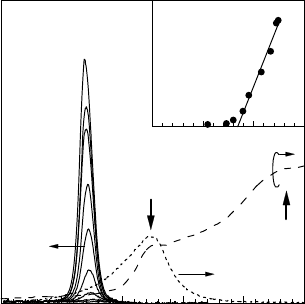
small compositional fluctuations in the barrier layers (well-depth fluctuations). Such RT
PL in the MQWs grown on the sapphire substrates was not found.
We performed high-power excitation experiments to determine the characteristics of
stimulated emission in ZnO MQWs in the optical pumping mode. Figure 12.8 s hows
stimulated em ission spectra of M QWs with x ¼ 0:12 and L
w
¼ 17:5A
that were
obtained at RT. Strong and s harp emission peaks wer e observed at 3.24 eV above a
very low threshold (I
th
¼17 kW cm
2
), and their integrated intensities rapidly increased
as the excitation intensity (I
ex
) increased, as can be seen in the inset. Although such
stimulated emission was not observed even at 4.2 K in the case using a sapphire
substrate, RT stimulated emission in MQWs studied here was observed. This is one of
the significant improvements achieved b y applying lattice-matching conditions to a
substrate.
The L
w
dependences of peak energies of the absorption and stimulated emissions are
summarized in Figure 12.9. Similar dependence of the threshold is also shown in
Figure 12.9(c). The stimulated emission energy is 100 meV lower than that of the
absorption peak. The lowest threshold value was 11 kW cm
2
in the case of L
w
of 47 A
.
We tested the high-temperature operation of the stimulated em ission f rom the view-
point of possible applications to devices. Figure 12.10 shows the temperature dependence
of the I
stim
I
ex
curves of a MQW with x ¼ 0:26 and L
w
¼4.2 nm in the temperature ran ge
of 294–377 K. Here, I
stim
is the intensity of the stimulated emission and I
ex
is the excitation
intensity. The threshold of the stimul ated emission (I
th
) increased gradually with
increasing temperature. The inset shows the temperature dependence of I
th
on a logarith-
mic scale. Characteristic temperature, which is an index of stability of threshold
PL Intensity
(arb. units)
3.63.53.43.33.23.1
Photon ener
gy
(eV)
Stimulated Emission Intensity (arb. units)
Absorbance
(arb. units)
L
W
= 18 Å
294 K
Nd:YAG
exc.
He-Cd
exc.
Well
Barrier
Intensity
20100
I
ex
(kW/ cm
–2
)
I
th
=
17 kW/ cm
–2
Figure 12.8 Excitation intensity (I
ex
) dependence of the stimulated emission spectra obtained
from a ZnO/Mg
0.12
Zn
0.88
OSL(L
w
¼1.8 nm) under the condition of pulsed excitation at RT.
Spontaneous PL (dotted line) under the condition of continuous-wave excitation and absorp-
tion (broken line) spectra are also shown. Inset shows the integrated intensity of the stimulated
emission peak as a function of I
ex
. Threshold intensity ( I
th
)is17kWcm
2
.
[
45
]
Ohtomo, A., et al.,
Room-temperature stimulated emission of excitons in ZnO/(Mg,Zn)O superlattices, Appl. Phys.
Lett, 77, 2004. Copyright (2000) with permission from American Institute of Physics
Stimulated Emission in MQWs 343
